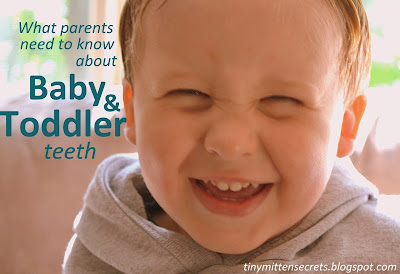In the past month,
Ella has taken to solid foods and sippy cups like a devoted Olympic gold
medallist. It wasn’t easy. But, the road to victory never is. Razzed yogurt.
Splattered formula. Mushed blueberries. And, protesting squeals. Much more of a
mess at this age than her older brother was. But, my goal to kick the bottle by
her first birthday is just three months away. So, “Operation Bottle Bye Bye” is
in overdrive.
I refuse to be the
parent with a three-year-old drinking juice from a bottle. Not only because
preschoolers are completely capable of drinking from cups, but mainly due to
the very serious risk of tooth decay and bottle mouth.
Bottle mouth? More
common than parents think. It’s when a baby/toddler keeps a bottle with soda,
sugary drinks juice, milk or formula in his or her mouth a lot during the day
(i.e. overnight bottle nursing, frequent sipping). The liquid ferments around the teeth and leads to enamel damage.
Eventually tooth decay.
At least 4 million
preschoolers suffer from tooth decay. Four
million. It’s an increase of more than 600,000 kids in the last decade,
according to Parenting.com.
A March 2012 NY
Times article stated that the number of preschoolers requiring extensive
dental work is on the rise. “Dentists nationwide say they are seeing more
preschoolers at all income levels with 6 to 10 cavities. The level of decay,
they added, is so severe, that they often recommend using general anesthesia
because young children are unlikely to sit through such extensive procedures.”
Still not
convinced? The LA Times reported that more than 50 percent of children
will have some tooth decay by age 5 and oral infection is the No. 1 chronic
disease in kids.
Yikes. Just picturing my little Jack. Almost three. His tiny feet not nearly reaching the dentist chair edge. Small cubby hand clutching my fingers as the dentist shifts a mask over his mouth. We have a dentist appointment Friday. Glad he brushes his teeth every day and we only let him sip water. Juice only at meals. It’s the addiction to sticky candy that worries me…
But, what most
parents don’t know is the risks. Tooth decay is mainly caused by bacteria.
Germs. Not by the lack of brushing or flossing. And, it’s more common among
young children than any other chronic illness.
Here’s a few
leading causes of tooth decay:
- Eating a
high-sugar diet (that includes all those processed and frozen foods!)
- Eating sticky
candy (Jack is totally guilty)
- Eating frequent
sweets or snacks
- Drinking beverages
with sugar between meals
Leading causes of
bottle mouth:
- Drinking
sweetened beverages from the bottle
- Too many bottles
after child’s first birthday (even milk in a bottle after 14 months can cause
decay)
- Going to bed with
a bottle
A few tips to curve
tooth decay in kids:
- Choose tap water,
not bottled water. Bottled water doesn't contain fluoride, which protects
against cavities.
- Visit the dentist
or have the pediatrician do an oral exam by age 1.
- Fight the battle to brush teeth. Start early
(as soon as the first tooth appears) and get in the habit of doing it twice a
day.
- Cut down on
snacks, especially with sugary foods (like raisins).
- If baby is placed
to sleep with a bottle, use water and nothing else.
- Wean baby of the
bottle by age 1, 14 months at the latest.
- Discuss a
fluoride supplement with a dentist or pediatrician for children older than six
months.
- Keep your mouth
clean. A study by the American Academy of Pediatrics Dentistry (AAPD) found
that in 71 percent of cases, the mother transmitted cavity-causing bacteria to
infants even before teeth erupted.
- Break the
pacifier addiction. The AAPD states the earlier it’s stopped, the less chance
it will lead to orthodontic problems.
- Limit the drinks.
Aside from juice, breastmilk and formula can also coat the teeth and lead to
tooth decay. Don’t let your child walk around with a sippy cup or bottle all
day.
- Wipe your baby’s
gums – even if there are not teeth – with a damp washcloth after feedings.
- Brush your
child’s teeth for at least 30 seconds after breakfast and before bed.
- Start using
fluorinated toothpaste at 2 years old. Begin flossing when two of his or her
teeth are touching.
Other resources:


8 comments:
Great tips! My son is 15 months and trying to brush his teeth is a battle to say the least. Keeping his teeth healthy is a high priority of mine even if he only has 8 right now.
Thanks for the great post!
Hi there! I'm a new follower from MBC and I'd love a follow back at www.sugarplumsandlollipops.blogspot.com and pinterest (I follow back all my pinterest followers)!
New follower from Mom Blog Club and http://motherbabychild.blogspot.com. This was an extremely informative post. I am very careful with our baby's teeth, but these stats are great to know, too. TY!
Thanks Mrs. O! I didn't realize the seriousness until I did a little research. Made me realize I need to start brushing our 9 month olds, even though she has none!
(FYI, the battle is worth it. My three-year-old just stopped fighting it, but has no cavities!)
Done!
As a former journalist, I feel it's my duty to share my facts! Glad you could find it helpful. Follow along and you'll see I share lots of resourceful info, among other things ;)
Love your name, BTW
Very informative... Great post! Visiting from blog hop social 39. Count me in as a new follower! :)
See you around I hope!
S.O.S. Mom
Http://sosmom.blogspot.com
Thanks for the follow Melissa! Check Tiny Mitten Secrets out on Facebook for more tips. See you around! (Love "SOS Mom" sure feel that way sometimes, lol)
Post a Comment